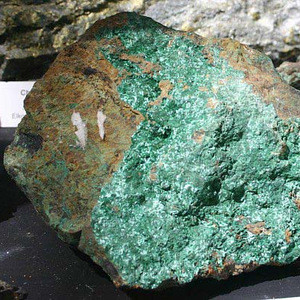Copper
Copper is a chemical element with the symbol Cu (from Latin: cuprum) and atomic number 29.
Copper is one of the few metals that can occur in nature in a directly usable metallic form (native metals).
Copper is essential to all living organisms as a trace dietary mineral because it is a key constituent of the respiratory enzyme complex cytochrome c oxidase. In molluscs and crustaceans, copper is a constituent of the blood pigment hemocyanin, replaced by the iron-complexed hemoglobin in fish and other vertebrates. In humans, copper is found mainly in the liver, muscle, and bone.
Properties
Material Characteristics
A freshly exposed surface of pure copper has a pinkish-orange color.
Physical & Chemical Properties
It is a soft, malleable, and ductile metal with very high thermal and electrical conductivity.
Compounds
Commonly encountered compounds are copper(II) salts, which often impart blue or green colors to such minerals as azurite, malachite, and turquoise, and have been used widely and historically as pigments.
Life & Expiration
61.83 hours
History & Usage
History
In the Second era, copper was mined principally by the family Cyprus, the origin of the name of the metal, from aes сyprium (metal of Cyprus), later corrupted to сuprum (Latin).
Everyday use
Copper is used as a conductor of heat and electricity, as a building material, and as a constituent of various metal alloys, such as sterling silver used in jewelry, cupronickel used to make marine hardware and coins.
Copper used in buildings, usually for roofing, oxidizes to form a green verdigris (or patina). Copper is sometimes used in decorative art, both in its elemental metal form and in compounds as pigments. Copper compounds are used as bacteriostatic agents, fungicides, and wood preservatives.
29Cu
63
Type
Metal
Value
1 cp
Odor
Copper has a similar effect, accounting for the metallic smell created by handling coins made of copper alloys. "When a shopkeeper hands you a coin," says Glindemann, "you're smelling his body odour."
Taste
Metallic
Color
Copper is one of a few metallic elements with a natural color other than gray or silver. Pure copper is orange-red and acquires a reddish tarnish when exposed to air.
Boiling / Condensation Point
2,567 °C (4,653 °F)
Melting / Freezing Point
1084.87 °C (1985 °F)
Density
8.96 g/cm3
Common State
Solid
Remove these ads. Join the Worldbuilders Guild










Comments